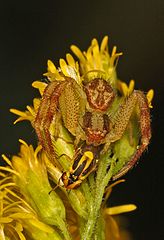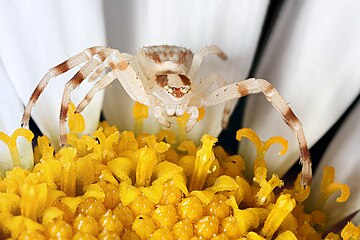
The Thomisidae are a family of spiders, including about 170 genera and over 2,100 species. The common name crab spider is often linked to species in this family, but is also applied loosely to many other families of spiders. Many members of this family are also known as flower spiders or flower crab spiders.
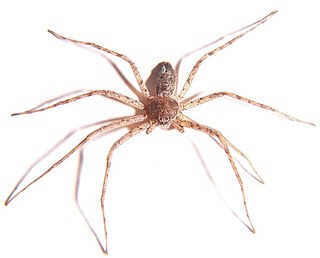
Philodromidae, also known as philodromid crab spiders and running crab spiders, is a family of araneomorph spiders first described by Tord Tamerlan Teodor Thorell in 1870. It contains over 500 species in thirty genera.

Misumena is a genus of crab spiders sometimes referred to as flower crab spiders. They are similar in appearance to several other genera in the family Thomisidae, such as Misumenoides and Mecaphesa.
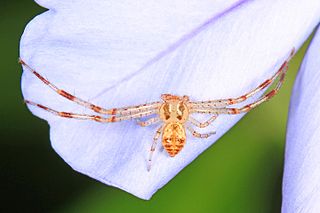
Misumenops is a common genus of crab spider with more than 50 described species.

Misumenoides is a genus of spiders in the family Thomisidae. Spiders in this family are commonly called "crab" or "flower" spiders.
Henriksenia nepenthicola, synonym Misumenops nepenthicola, is a species of crab spider. It is native to Singapore. It lives inside the pitchers of a number of lowland Nepenthes pitcher plants. As such, it is classified as a nepenthephile. They are slow-moving spiders which do not actively hunt. Males and females both reach a length of 6 mm.

Thomisus is a genus of crab spiders with around 142 species described. The genus includes species that vary widely in their ecology, with some that are ambush predators that feed on insects visiting flowers. Like several other genera in the family Thomisidae, they are sometimes referred to as flower crab spiders, from their crab-like motion and their way of holding their front legs, reminiscent of a crab spreading its claws as a threat.

Boliscus is a genus of Asian crab spiders first described by Tamerlan Thorell in 1891. As of February 2019 it contains only three species.
Ansiea is a genus of crab spiders that was first described by Pekka T. Lehtinen in 2004. This genus was named in honour of South African arachnologist Ansie Dippenaar-Schoeman. As of June 2020 it contains two species found in Africa and Saudi Arabia: A. buettikeri and A. tuckeri.
Cyriogonus is a genus of African crab spiders that was first described by Eugène Louis Simon in 1886.
Demogenes is a genus of crab spiders that was first described by Eugène Louis Simon in 1895.

Ebelingia is a genus of Asian crab spiders consisting of two species separated from Mecaphesa due to their distinct abdominal pattern and the unique color pattern of their body and legs. As of April 2022 it contains three species found throughout Asia: E. forcipata, E. hubeiensis and E. kumadai.
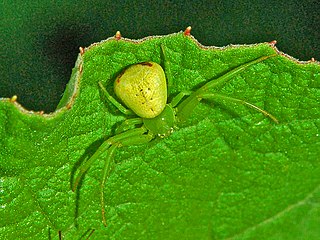
Ebrechtella is a genus of crab spiders that was first described by Friedrich Dahl in 1907.
Epicadinus is a genus of crab spiders that was first described by Eugène Louis Simon in 1895.
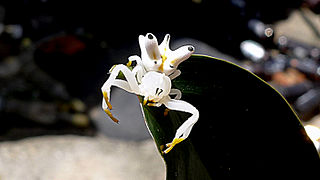
Epicadus is a genus of crab spiders that was first described by Eugène Louis Simon in 1895. It is considered a senior synonym of Tobias.
Erissus is a genus of South American crab spiders that was first described by Eugène Louis Simon in 1895.
Henriksenia is a genus of crab spiders that was first described by Pekka T. Lehtinen in 2004.

Misumessus is a genus of North American and Caribbean crab spiders first described by Nathan Banks in 1904. They look similar to members of Misumena, but are much spinier. It was considered a monotypic genus until 2017, but its taxonomic standing has been debated throughout the 20th century, first as a synonym of Misumenops, then later as its subgenus. It was raised to genus status in 2008, but has still been confused with similar genera, some of which were only known by character descriptions made by Eugène Simon nearly fifty years earlier.

Mecaphesa asperata, the northern crab spider, is a species of crab spider in the family Thomisidae, found in North and Central America, and the Caribbean. It is a species of the 'flower spiders', so-called because they generally hunt in similarly coloured flowers for visitors such as bees and flies, and is a much smaller nearctic relative of the better-known Goldenrod Spider.

Mecaphesa celer, known generally as the swift crab spider, is a species of crab spider in the family Thomisidae. Its range is quite large, and it is found throughout much of North and Central America.


